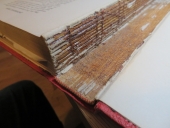
 8
8




Invasive plants are Earth's way of insisting we notice her medicines. Stephen Herrod Buhner
Everyone learns what works by learning what doesn't work. Stephen Herrod Buhner
 2
2




Sometimes the answer is nothing





 3
3






You can repair books with gaffer's tape, packing tape, white glue and denim, whatever but if you want your repair to look like a "book" you'll need book binding cloth and PVA glue.
You can order those online or find them at most any scrap-booking store.
The PVA glue is designed to bond paper like no other glue I have ever encountered and book binders cloth is designed to take a lot of abuse from handling and bending as well as having a paper backing that lends itself to working with PVA.

I chose to glue the spine to the book binders cloth first. This could have been done differently. The only critical thing to remember is to not glue the spine to the book itself. It needs to move as part of the cover and hinge rather than be affixed to the pages.
You'll also want to make a couple small cuts so you have tabs the width of the spine to fold over and glue to the spine itself. This allows for a clean fold and nicer edge on the cover as well as the spine. Easier to see in the images if you just follow those.
After attaching the spine simply line up the cloth and glue first one side and then the other to the cover. You might want to use a bone burnisher to smooth things out but it isn't really necessary on such a simple repair.
I wrapped my cloth fairly snug to help hold the book together. PVA dries very quickly so be as precise as possible when gluing it down. You likely won't get a second chance.

Invasive plants are Earth's way of insisting we notice her medicines. Stephen Herrod Buhner
Everyone learns what works by learning what doesn't work. Stephen Herrod Buhner
 5
5




A human being should be able to change a diaper, plan an invasion, butcher a hog, conn a ship, design a building, write a sonnet, balance accounts, build a wall, set a bone, comfort the dying, take orders, give orders, cooperate, act alone, solve equations, analyze a new problem, pitch manure, program a computer, cook a tasty meal, fight efficiently, die gallantly. Specialization is for insects.
-Robert A. Heinlein

|
As if that wasn't enough, a dog then peed on the tiny ad.
Learn Permaculture through a little hard work
https://wheaton-labs.com/bootcamp
|









